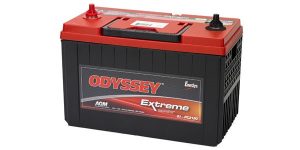The primary trend observed in the lead-acid battery market is the technological advances in these energy storage devices. These batteries are used in many applications and are in high demand due to their compatibility with various consumer electronics. Due to the limitations of traditional lead-acid batteries, companies have begun manufacturing high-performance variations in meeting the performance standards of technologically advanced products.
Related book: - Handbook on Automobile & Allied Products
The operation of the batteries is based on the electrochemical cell. There are two electrodes, one positive and one negative, which generate an electric current when connected in a closed circuit. That is, the electrons flow spontaneously from one electrode to another. Batteries are made up of several pairs of electrodes that are located in separate compartments called cells. In the cells, the electrodes are immersed in a solution that is called the electrolyte.

In lead-acid batteries, the positive electrode consists of a lead plate coated by lead (II) oxide, PbO2, and the negative electrode by spongy lead. They are called "acid" lead batteries because they use a sulphuric acid solution as the electrolyte.
If we place the cells in series, alternating positive and negative, we can add each of them' voltages and finally obtain a higher voltage (6 V, 12 V, 24 V). If, on the other hand, we place the cells in parallel, positive next to positive and negative next to negative, we will be able to increase the intensity of the battery.
When the battery is completely discharged, let's say the electrodes "have broken down," their nature has changed. To return to the initial state, we provide electrical energy to the battery. We charge it, making the current circulate opposite to the usual one, "recomposing" those electrodes. Thus, once returned to the initial state, the battery can continue to provide electricity thanks to the electrons' spontaneous movement.
Why is Lead-acid Battery Business Profitable?
The global lead-acid battery market is projected to grow from an estimated $ 41.6 billion in 2019 to $ 52.5 billion in 2024, with a CAGR of 4.7% during the forecast period. The booming telecommunications sector and the expanding data industry need cost-effective battery storage solutions to provide backup power supplies that are expected to be the most critical catalysts in driving this market's development.
Related project: - Lead Acid Battery Manufacturing Industry
The motor segment will continue to dominate the lead-acid battery market by type from 2019 to 2024.
The lead-acid battery market is divided into fixed and mobile types by type. This segmentation is based on the nature of the application in which the battery unit is used. Lead-acid batteries are used more often because they are cost-effective. This battery's nature also affects the application in which it is used and the type of user who implements it.
Significant demand for data center installations is expected shortly. As data generation increases, so do data processing capacity over the next few years. Data centers use lead-acid batteries so that demand will increase accordingly.
Major players active in India's lead-acid battery market include Exide Industries Limited, Amara Raja Batteries Limited, Livguard Energy Technologies Private Limited, and Luminous Power Technologies Pvt. Ltd, HBL Power Systems Limited, etc.

Related videos: - Automobile Industry
Conclusion
NPCS provides all kinds of data and information about the baby diaper business model and its business analysis. Both top-down and bottom-up approaches have been used to analyze and forecast the lead-acid battery market in India. Employees of a large company were interviewed through telephone conversations to extract and validate the sources' information.
Reports of various secondary sources such as white papers and secondary literature on lead-acid batteries, Smart Cities Mission, Federation of Indian Chambers of Commerce (FICCI), Ministry of New Renewable Energy, Ministry of Housing and Poverty Mitigation Urbana, lead-acid batteries, etc. Calligraphy, the International Monetary Fund, and the World Bank were also investigated by the Niir Project Consultancy Services (NPCS). Besides, detailed and detailed scrutiny of the information was conducted to understand each external or internal policy or factor that could increase or decrease the demand for lead-acid batteries in India and worldwide.
EVA_Art2021
#DetailedProjectReport #businessconsultant #BusinessPlan
#feasibilityReport #NPCS #industrialproject #entrepreneurindia #startupbusiness #BusinessIdeas #StartupBusinessIdeas #BusinessOpportunity #ProductionBusiness #ManufacturingBusiness #LeadAcidBatteries #LeadAcidBatteryIndustry #BatteriesIndustry #AutomobileProducts #AutomobileIndustry #AutomobileProduction #AutomobileManufacturingIndustry #EmpoweringBusiness #ManufacturingBusiness #AutomobileBusinessIdea #ProductionBusiness #ManufacturingBusinessIdea